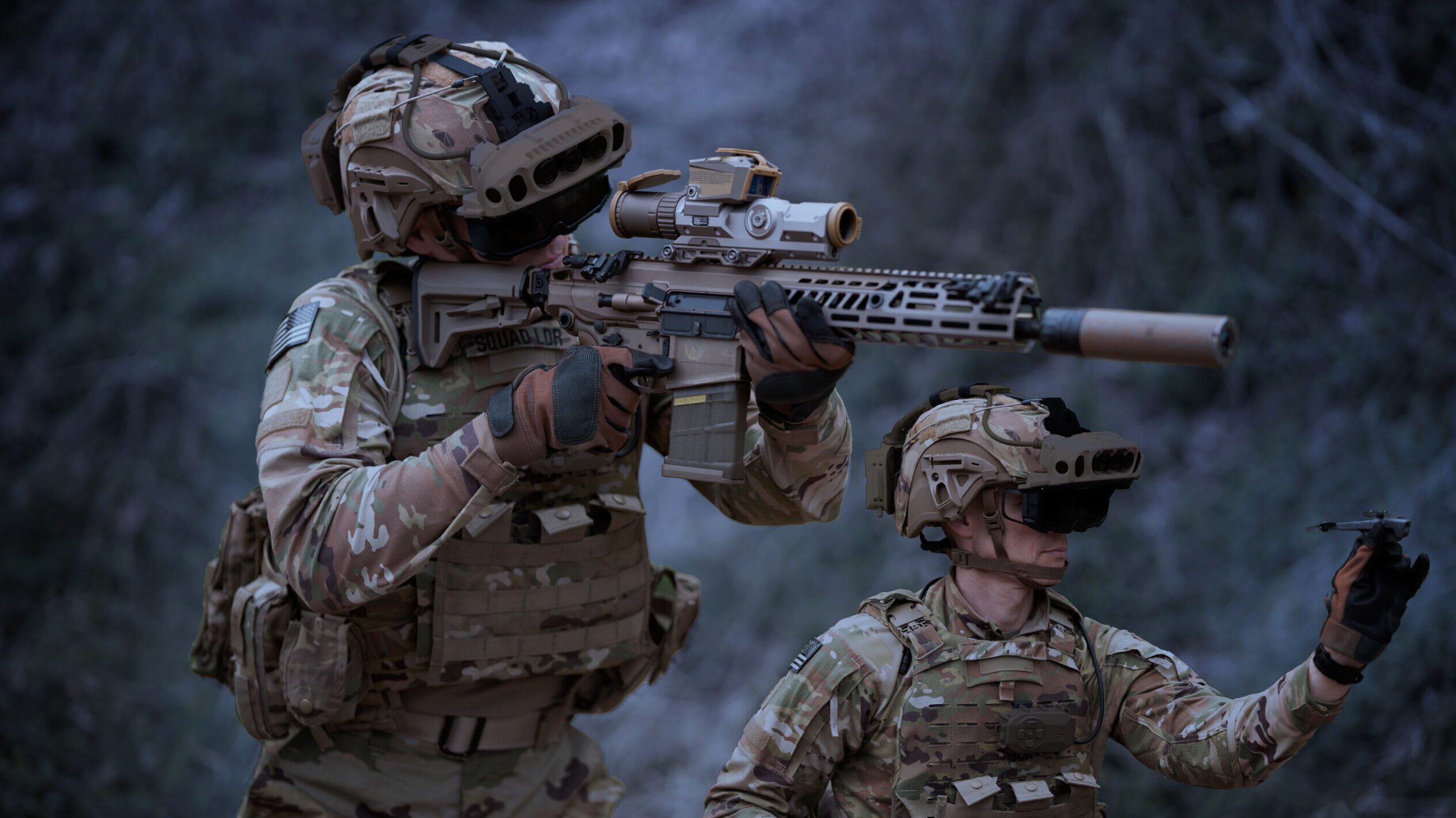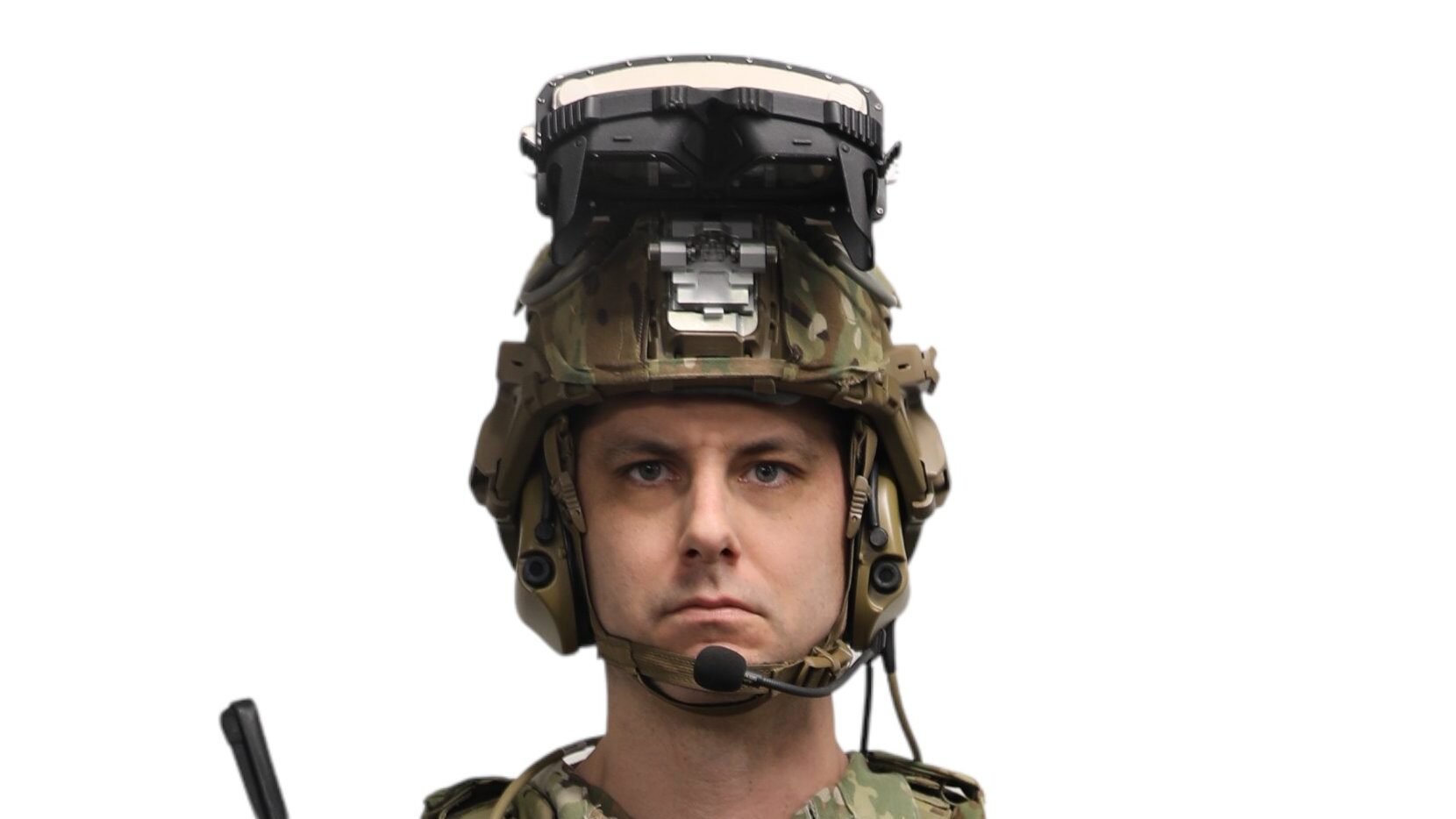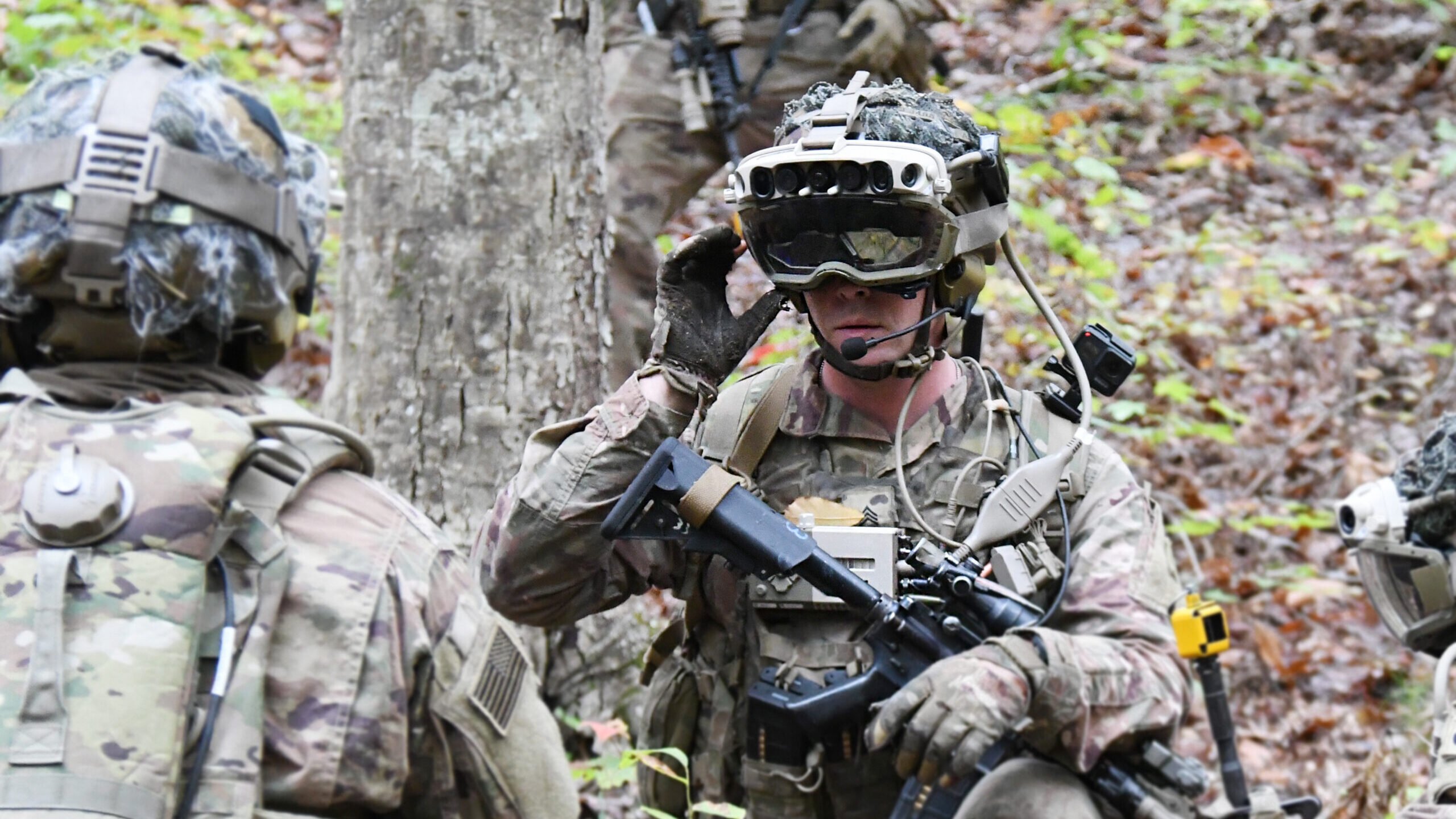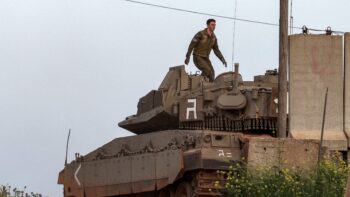
Imagery of the US Army’s vision for IVAS 1.2 in action. (Army photo)
WASHINGTON— As Army leaders make the rounds on Capitol Hill, they’re carrying a stark message about the Integrated Visual Augmentation System (IVAS) program: the service’s struggling, would-be heads-up display of the future is on its last chance.
Over the past several years, the Army’s foray with Microsoft into militarizing the HoloLens 2 heads-up display would not be considered smooth. Soldiers have shunned the technology in operational tests due, in part, to software glitches and physical side effects. Despite initial plans to spread the technology across the service, leaders have limited the initial fielding to 10,000 IVAS units while it works with the company to overhaul the hardware’s design.
“If Congress gives us the money that we’ve requested for IVAS in this year’s budget, we are going to use that to work with Microsoft to get the system to a place where our soldiers will want to use it,” Army Secretary Christine Wormuth told Senators on May 2. “And, if Microsoft isn’t able to do that, we will not develop the program further. We’re not going to spend $22 billion on a system if it doesn’t work.”
Doug Bush, the Army’s head of acquisition, has made a similar vow and promised that he is prepared to admit failure if IVAS testing does not prove “very quickly that it’s capable and going to get us what we need.”
“The Army is absolutely prepared to end that arrangement and seek a new competition,” Bush told Senators during an April 18 hearing.
Wormuth and Bush did not detail when the service plans to make that critical determination on the path ahead. But in an exclusive interview, two key program officials told Breaking Defense that there are a number of new benchmarks laid out internally that will help decide the program’s future.
Among the new information laid out by the officials:
- The Army has 5,000 units of the IVAS 1.0 early iteration but is unable to distribute them due, in part, to a budget shortfall. It is now determining if there is a pathway for a limited fielding to occur before lawmakers decide on 2024 funding.
- Microsoft has completed a new software release for IVAS 1.0 and 1.1, and a test report should be finalized this month.
- Microsoft has found a new low-light camera for the 1.1 version and the service is aiming to have it ready for soldiers by the end of September 2024.
- If IVAS 1.1 testing is a success, the service anticipates spending $62,000 for each unit, a 33 percent increase over the price of the 1.0 system.
- The larger IVAS redesign under the 1.2 effort is ongoing, and the service plans to begin testing a prototype later this year with a goal of having it ready for soldiers towards the end of 2025.
- The IVAS 1.2 design will move the computer puck from the soldier’s chest to the back of their helmet, but will weigh more than the older designs.
Ultimately, the program may be on its last strike – but the capability could be so game-changing for the Army that the service is trying to make it all work.
“To me, IVAS is transformational. It’s going to fundamentally change the way our soldiers operate on the battlefield,” Army Chief of Staff Gen. James McConville told Senators earlier this month. “When we take a look at where we are with resources, we want to give the next three to five years to get that edge that’s going to transform how our soldiers are going to fight.”
Stalled Fielding
IVAS problems became public in 2021, after the Army conceded that it had gotten ahead of itself by issuing Microsoft a production contract just weeks before discovering the technology was not ready for soldiers.
The service announced it would delay fielding from 2021 until 2022 to make hardware and software fixes. However, those changes were not enough and an operational test with the device in mid-2022 found that software glitches persisted. More concerning, soldiers continued to complain about the physical side effects from wearing the device (nausea and dizziness) and about its night-vision capability.
Again, the Army opted to revamp the program and laid out a larger restructure initiative where it would buy 5,000 units of the existing device, called IVAS 1.0, and field those to schoolhouses and recruiters by August 2023 – approximately two years later than initially planned. At the same time, it would make software changes and add in a new low-light camera for IVAS 1.1 in order to acquire 5,000 for non-light infantry units, such as Stryker units, in the late 2023-24 timeframe, while working on a massive form factor overhaul for IVAS 1.2.

Shown here is an IVAS 1.2 rendering where soldiers can flip the flat display up. (US Army)
And yet, while IVAS 1.0 was supposed to be fielded by August, the 5,000 units are sitting in storage with no clear plan for distribution, according to the project manager for Soldier Warrior Col. Troy Denomy and IVAS product manager Lt. Col. Denny Dresch. The two walked Breaking Defense through the state of play, from their vantage point, during a May 5 interview.
Denomy said that while the service has accepted all 5,000 IVAS 1.0 units, his shop has not fielded a single one, in part because it has not been told where to send those initial devices. Additionally, since lawmakers’ concern about the health of the program prompted them to zero out all FY23 procurement dollars, there isn’t money to field those devices.
“We’re seeing how much [money] we have to do a limited fielding in FY23 and working with the [cross-functional team] CFT on those options…but the balance of most of those will be predicated on FY24 funding,” he added.
The Army’s FY24 budget request, currently being vetted by lawmakers, includes nearly $90 million for IVAS procurement and millions more for research and development work next year. If lawmakers approve that $90 million procurement figure, Demony said, the service will not buy additional IVAS devices with it but instead use it to field those 5,000 IVAS 1.0 and, eventually, the 5,000 IVAS 1.1.
However, if lawmakers reduce that figure, zero it out or fail to pass a spending bill, IVAS units will likely remain in storage — and realistically, given the challenges to the programs and the already-in-the-works upgrades, may never leave.
Moving From 1.0 To 1.1
In January, the service and Microsoft hashed out the terms of a revised deal that includes a pathway for improving software reliability via a new software release for both the 1.0 and the future 1.1 versions.
Denomy said that software release has been completed and tested, and the Army Test and Evaluation Command report should be completed later this month.
“All indications are that it was very favorable,” Denomy added.
While the Army wants this software fix in place for its 1.1 version to move forward, it is also eyeing an improved low-light camera. Denomy said the company and Army have selected that new camera and the parts are on order, but noted that there is a lead time in receiving them.
Dresch said the Army is planning to host an operational test with 1.1 version in the second quarter of FY24 and, if the improvements are adequate and funding is in place, those additional 5,000 units could potentially be in soldiers’ hands before FY24 ends on Sept. 30 2024.
While work to move to IVAS 1.1 is progressing, the per-unit price tag has been edging up. The per unit cost for IVAS 1.0 hovered around $46,000, while each of the 1.1 versions will cost taxpayers around $62,000. Denomy said this sharp increase is due to the contract renegotiations and the fact the Army plans to buy two-thirds fewer systems than previously planned while it works on the future 1.2 version.
He noted that it is not yet clear what the target price will be for that future 1.2 version, in part because development is still ongoing.

Soldiers from the 82nd Airborne Division used a prototype of the Integrated Visual Augmentation System (IVAS) during a trench clearing exercise at Fort Pickett, Va. (Bridgett Siter/US Army)
Can IVAS 1.2 Be A Major Leap Forward?
Soldiers using the initial IVAS form factor have had a lot to say of the device. The problem is, that feedback wasn’t good.
“In the ops demo, the infantry company was more successful accomplishing their operational missions with their current equipment than with IVAS 1.0,” the Director of Operational Test and Evaluation wrote in a report on FY22 testing activities. “Soldiers hit fewer targets and engaged targets more slowly with IVAS 1.0 than with their current equipment on the buddy team [live] fire range.”
Additionally, while using IVAS 1.0, the majority of soldiers reported at least one physical impairment like disorientation, dizziness, eyestrain, headaches, motion sickness and nausea, neck strain and tunnel vision.
“Soldiers cited IVAS 1.0’s poor low-light performance, display quality, cumbersomeness, poor reliability, inability to distinguish friend from foe, difficulty shooting, physical impairments and limited peripheral vision as reasons for their dissatisfaction,” the Pentagon’s chief weapons testing office added.
The Army is seeking to remedy most of those problems with the 1.2 version redesign, and potentially have it ready for fielding towards the end of FY25 if things go smoothly.
To get there, the service anticipates receiving initial new prototypes in early FY24 (possibly this October) to use in a series of “knowledge points” leading up to a user assessment towards the end of December 2023, Dresch said. Based on those findings, the service will make changes and continue testing out incremental improvements in the lead up to an operational test in the third quarter for FY25 before fielding it by Oct. 1 2025.
But this is just a roadmap and subject to change, officials stressed. “Everything is condition based,” Dresch added.
So what are the big changes between IVAS 1.0/1.1 and 1.2?
For starters, the heads-up display is a complete revamp. The early iterations have a helmet-like display, not easy to remove, that provides them with a 70-degree field of view. In contrast, the redesign will shrink that field of view to 60-degrees, based around a “flat display” against the face that has hinges so soldiers can flip it up, Denomy said.
“The trade that we provided in that was to reduce the field of view a little bit more but the benefit was improved clarity of the display and more in line with the user’s eyes,” he added.
For the IVAS 1.0/1.1 versions, soldiers wear the computer puck on their chests. That puck is moving to the back of the helmet for the 1.2 version to provide a “better center of gravity” that will not make soldiers feel as “front heavy,” Denomy explained.
As a result of this move, Microsoft is able to reduce the length of the cord connecting the puck to the heads-up display, which should improve connectivity between the two.
Improvements to the thermal camera are also in the works to provide soldiers with better clarity while demanding less battery power, along with additional work to shore up software reliability.
All of those changes are expected to slightly drive up the weight of IVAS 1.2 but provide soldiers with a capability that better fits their body. For now the new design’s weight is around 3.4 pounds but the company and service are shaving that down gram by gram, with the goal of reaching 2.9 pounds — just above the weight of the current configuration that sits at 2.4 pounds.
It will likely take time to see if those changes are enough to win soldiers approval.
“We’ve continued to learn and adapt as we’ve gone: We’ve modified our plan and approach, at least twice,” Denomy said. “Continuing to better understand how the system will be employed… [is] why we are continuing to pursue and will field 1.0 and 1.1 down the campaign of learning.”
Norway’s top officer on his ‘biggest challenge,’ next frigate and new NATO neighbors
Gen. Eirik Kristoffersen, Norway’s Chief of Defense, talks to Breaking Defense about his plans for spending on new frigates and subs, the challenges of upgrading Norway’s “digital backbone” and refilling the military’s stocks.


























